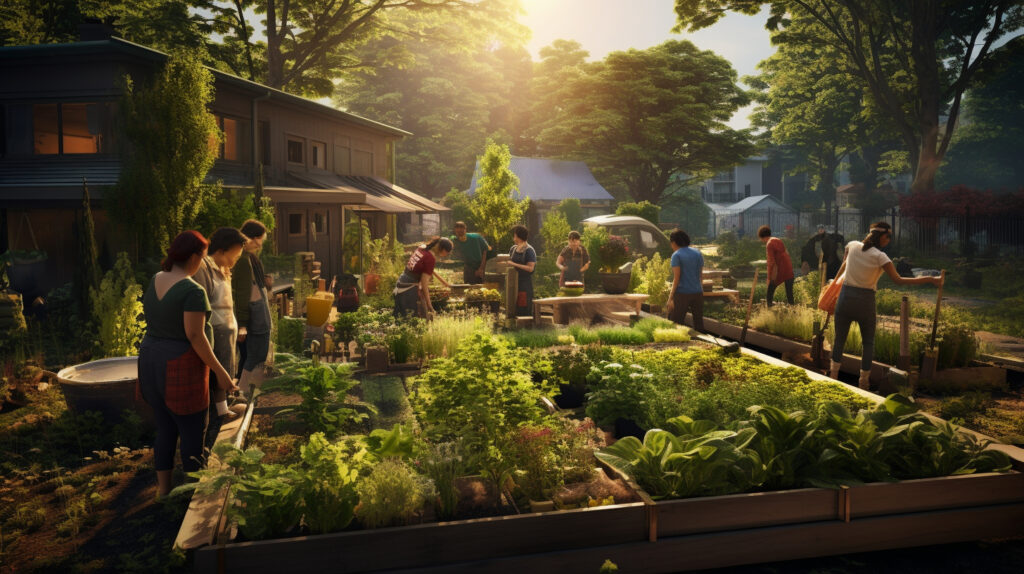Welcome, my friend, to the world of sustainable change and sustainable projects! In this article, we will delve into the fascinating realm of creating long-lasting, positive transformations in our society and the environment.
Sustainable change refers to making enduring improvements that have a positive impact on the well-being of people and the planet. It involves implementing projects and initiatives that address social and environmental challenges in a way that is sustainable both in the short and long term.
Imagine being part of a movement that not only tackles pressing issues but also ensures that the solutions put in place will continue to make a difference for generations to come. This is the power of sustainable projects.
Through our journey, we will explore the various aspects of creating and implementing sustainable projects, including identifying social and environmental challenges, developing project proposals, building stakeholder relationships, addressing challenges and roadblocks, measuring the impact of projects, and scaling up successful initiatives.
Are you ready to embark on this exciting adventure? Let’s dive into the world of sustainable change and discover how we can make a difference together!

Understanding Sustainable Change
Defining Sustainable Change
Sustainable change refers to long-lasting and impactful transformations in social and environmental conditions that are achieved through sustainable projects. It involves addressing pressing issues and creating lasting solutions that benefit both current and future generations. Sustainable change goes beyond short-term fixes and aims to create a positive and enduring impact on society and the environment.
Importance of Sustainable Projects
Sustainable projects play a crucial role in driving sustainable change. They focus on addressing social and environmental challenges by implementing solutions that are economically viable, socially equitable, and environmentally responsible. These projects are essential for achieving the United Nations’ Sustainable Development Goals (SDGs) and creating a more sustainable future.
Some key reasons why sustainable projects are important include:
- Environmental Conservation: Sustainable projects help protect and preserve natural resources, reduce pollution, and mitigate the impacts of climate change.
- Social Impact: These projects address social inequalities, promote inclusivity, and improve the wellbeing of communities. They often prioritize the needs of marginalized groups and vulnerable populations.
- Economic Growth: Sustainable projects stimulate economic growth by creating new jobs, promoting entrepreneurship, and fostering innovation.
- Long-Term Sustainability: By considering the long-term implications of their actions, sustainable projects aim to create lasting change that benefits present and future generations.
Characteristics of Successful Sustainable Projects
Successful sustainable projects share common characteristics that contribute to their effectiveness and impact. These include:
- Holistic Approach: Sustainable projects take a holistic approach, considering social, environmental, and economic aspects of a problem and their interconnectedness.
- Collaboration: Successful projects involve multiple stakeholders, including local communities, NGOs, government agencies, and businesses. Collaboration facilitates knowledge sharing, resource pooling, and diverse perspectives.
- Community Engagement: Involving the target beneficiaries in project planning and implementation ensures their ownership and promotes sustainability in the long run.
- Adaptive Management: Sustainable projects embrace flexibility and adaptability, taking into account changing circumstances, technological advancements, and evolving needs.
- Monitoring and Evaluation: Regular monitoring and evaluation help measure the project’s progress, identify areas of improvement, and demonstrate the project’s impact.
- Capacity Building: Empowering individuals and communities through training and skill development enables them to sustain the positive changes brought about by the project.
Sustainable change can only be achieved through a comprehensive understanding of the social and environmental challenges at hand, as well as the development and implementation of well-thought-out sustainable projects. By addressing these challenges head-on and engaging with stakeholders, we can create a brighter and more sustainable future for all.

Identifying Social and Environmental Challenges
When embarking on a sustainable project, it is crucial to first identify the social and environmental challenges that need to be addressed. By understanding these challenges, we can develop effective solutions that have a lasting impact. Here are some key steps in the process of identifying social and environmental challenges:
Researching social and environmental issues
To effectively identify challenges, thorough research is necessary. This involves gathering data, conducting interviews, and consulting experts in the field. By understanding the root causes of social and environmental issues, we can design projects that tackle the problem at its core.
Needs assessment for sustainable projects
Once we have a clear understanding of the challenges, it’s important to conduct a needs assessment. This involves engaging with the community and stakeholders to determine the specific needs and priorities. By involving the people who are directly impacted by the challenges, we can ensure that our projects are tailored to their needs and aspirations.
Identifying target beneficiaries
Identifying the target beneficiaries is crucial for the success of a sustainable project. Who will benefit the most from the project? By understanding the demographics and specific needs of the target beneficiaries, we can create solutions that are relevant and impactful.
Example: Addressing water scarcity in a rural community
Let’s take the example of a sustainable project aimed at addressing water scarcity in a rural community. In this case, the social and environmental challenges may include:
- Limited access to clean drinking water
- Dependency on contaminated water sources
- Lack of sanitation facilities
- Negative impact on health and well-being
Through research and needs assessment, we can identify the specific needs and priorities of the community. By involving the community members as key stakeholders, we can design a sustainable project that provides access to clean water, improves sanitation, and educates the community about water conservation.
Keep in mind that each project and community will have its unique challenges. It’s important to adapt the approach based on the specific context and needs of the community.
By identifying the social and environmental challenges, we lay the foundation for effective and impactful sustainable projects. This process ensures that our efforts are focused on addressing the root causes of these challenges and creating long-lasting change. So, let’s dive deeper into the next step – developing a sustainable project proposal!
Developing a Sustainable Project Proposal
Creating a sustainable project proposal is a crucial step in implementing impactful and effective initiatives. It lays the foundation for your project’s goals, objectives, and actions. Here are some key steps to consider when developing a sustainable project proposal:
Establishing project goals and objectives
Setting clear and well-defined goals and objectives is vital for the success of any project. When developing a sustainable project proposal, consider the following:
- Identify the problem: Start by understanding the social or environmental issue you aim to address. This will help you articulate your project’s purpose more effectively.
- Define your goals: Determine the desired outcomes you want to achieve through your project. Make sure these goals align with the needs of the target beneficiaries and contribute to the overall sustainable development agenda.
- Outlining objectives: Break down your goals into specific, measurable, attainable, relevant, and time-bound (SMART) objectives. These objectives act as milestones for tracking progress and evaluating impact.
Creating an action plan
An action plan outlines the steps and activities required to achieve your project objectives. Here’s how you can create an effective action plan:
- Identify strategies: Determine the strategies and approaches you will employ to address the identified problem and achieve your project objectives. This may include community engagement, capacity building, advocacy, or infrastructure development.
- Define tasks and responsibilities: Assign specific tasks and responsibilities to team members or project stakeholders. Clearly defining roles ensures a coordinated effort and accountability.
- Create a timeline: Develop a timeline that includes key milestones, deadlines, and the sequence of activities. This helps in managing resources and tracking progress.
- Consider resources: Identify the resources (financial, human, and material) needed to implement the project. This includes budgeting, securing funding, and mobilizing the necessary skills and expertise.

Budgeting and resource allocation
Developing a budget and efficiently allocating resources are essential for the smooth execution of your sustainable project. Consider the following steps:
- Estimate costs: Identify and estimate the costs associated with each activity. This may include personnel salaries, materials, training, transportation, and overhead expenses.
- Prioritize expenses: Determine the allocation of resources based on the priorities and impacts of each activity. Ensure that essential elements receive sufficient funding.
- Seek funding: Explore various funding sources, such as grants, donations, sponsorships, or partnerships. Prepare a compelling case for your project and seek financial support from relevant organizations or individuals.
- Track and manage expenses: Implement a system to track project expenses and ensure adherence to the allocated budget. Regularly review and adjust spending if necessary.
By developing a comprehensive and well-thought-out project proposal, you increase the chances of obtaining support and successfully implementing your sustainable project. Remember to align your goals, objectives, and action plan with the specific needs of the community or environment you aim to benefit. Through effective planning, you can create lasting positive change and contribute to a more sustainable future.
Building Stakeholder Relationships
Building strong and meaningful relationships with stakeholders is crucial for the success of any sustainable project. Stakeholders include local communities, non-governmental organizations (NGOs), government agencies, and other individuals or groups who have a vested interest or are affected by the project. Here are some key steps to effectively build stakeholder relationships:
Engaging with Local Communities
- Establish a presence: Show your commitment and build trust by actively engaging with the local community. Attend community meetings, listen to their concerns, and address any issues that arise.
- Involve community members: Encourage community participation and involvement in decision-making processes. Seek their input and let them play an active role in shaping the project.
- Cultural sensitivity: Respect and understand the local culture, traditions, and values. Consider how your project can align with and benefit the community’s way of life.
Collaborating with NGOs and Government Agencies
- Identify key partners: Collaborate with local NGOs and government agencies that have expertise and experience in the project’s focus area. Seek their input, guidance, and support throughout the project lifecycle.
- Leverage resources: NGOs and government agencies often have access to valuable resources such as funding, networks, and infrastructure. By collaborating with them, you can leverage these resources to enhance the project’s impact.
- Establish clear roles and responsibilities: Define the roles and responsibilities of each stakeholder involved in the project. Clear communication and collaboration between all parties are essential for seamless project implementation.
Implementing Effective Communication Strategies
- Open and transparent communication: Maintain open lines of communication with stakeholders throughout the project. Regularly update them on project progress, challenges, and achievements to keep them informed and engaged.
- Tailor communication methods: Consider the preferences and accessibility of different stakeholder groups when choosing communication methods. Use a mix of methods such as community meetings, social media, newsletters, and direct engagement to reach a diverse audience.
- Address concerns and feedback: Actively listen to stakeholder concerns and feedback and take appropriate actions to address them. By demonstrating responsiveness, you can build trust and strengthen relationships.
“Effective stakeholder engagement is not a one-time event, but an ongoing process of collaboration, communication, and shared decision-making.” – Anonymous
Building strong stakeholder relationships requires continuous effort and commitment. By actively engaging with local communities, collaborating with NGOs and government agencies, and implementing effective communication strategies, you can foster support, build trust, and create a foundation for the long-term success of your sustainable project.
Implementing Sustainable Projects
Implementing sustainable projects is a crucial step in creating positive and lasting change in communities. It is the point where plans are put into action and tangible results are achieved. Whether you are working on a social or environmental project, the implementation phase is where you have the opportunity to make a real difference. In this section, we will explore the key aspects of implementing sustainable projects and how to ensure their success.
Effective Project Management
One of the most important factors in successfully implementing sustainable projects is effective project management. This involves planning, organizing, and coordinating all the necessary activities to achieve project goals. Here are some key steps to consider:
- Develop a detailed project plan: A well-defined project plan outlines the activities, timelines, and resources required for each stage of the project. It serves as a roadmap for the implementation process and helps keep everyone on track.
- Assign responsibilities: Clearly define the roles and responsibilities of each team member involved in the project. This ensures that everyone understands their tasks and knows what is expected of them.
- Monitor progress: Regularly assess the progress of the project to ensure tasks are being completed on time and that the project is moving in the right direction. This can be done through regular meetings, progress reports, and performance evaluations.
Ensuring Community Participation
In order to create sustainable change, it is essential to involve the community in the project implementation process. Their participation not only ensures that the project meets their needs but also increases their sense of ownership and commitment. Here are some ways to foster community participation:
- Engage the community from the start: Involve the community in the planning phase of the project. Seek their input, listen to their ideas, and incorporate their feedback into the project design. This sets the foundation for a collaborative and inclusive process.
- Build local capacity: Provide training and skill-building opportunities to community members. This empowers them to take an active role in the implementation phase and enables them to sustain the project even after it has been completed.
- Create open lines of communication: Establish clear channels of communication with the community. Regularly update them on project progress, seek their input, and address any concerns or feedback they may have. This helps build trust and ensures that the project remains responsive to their needs.
Monitoring and Evaluation
Monitoring and evaluation are important components of implementing sustainable projects as they allow you to track progress, measure impact, and make informed decisions. Here are some key steps in the monitoring and evaluation process:
- Develop indicators and metrics: Identify key indicators that will help measure the success of the project. These can include quantitative measures such as the number of beneficiaries reached or qualitative measures such as changes in behavior or attitudes.
- Collect and analyze data: Collect data on the identified indicators throughout the project implementation phase. This can be done through surveys, interviews, observations, or other data collection methods. Analyze the data to assess the project’s performance and identify areas for improvement.
- Report and disseminate findings: Share the results of the monitoring and evaluation process with stakeholders, including the community, funders, and project partners. This transparency allows for accountability and learning from the project’s successes and challenges.
Implementing sustainable projects requires careful planning, effective project management, community participation, and ongoing monitoring and evaluation. By incorporating these elements, you can maximize the impact of your project and ensure its long-term success. Remember, sustainable change is a journey, and the implementation phase is a critical step towards creating a better future for all.
Overcoming Challenges and Roadblocks
Implementing sustainable projects can be a rewarding but challenging endeavor. Along the way, you may encounter various roadblocks and obstacles that could hinder your progress. However, with the right approach and mindset, these challenges can be overcome. Here are some common challenges and strategies to address them:
Addressing funding issues
One of the biggest challenges in implementing sustainable projects is securing funding. Lack of financial resources can significantly impact the project’s success. Here’s how you can address funding issues:
- Explore diverse funding sources: Look beyond traditional funding avenues and consider alternative sources such as grants, corporate sponsorships, crowdfunding, or partnerships with other organizations.
- Create a compelling project proposal: Develop a comprehensive and persuasive project proposal that clearly outlines the project’s goals, objectives, and potential impact. Highlight how your project aligns with the values and priorities of potential funders.
- Build long-term relationships with donors: Cultivate relationships with donors by keeping them informed about the project’s progress and impact. Show them how their investment is making a difference and the potential for long-term sustainability.
Dealing with resistance and skepticism
Resistance and skepticism from stakeholders can pose significant challenges to the success of sustainable projects. Here are strategies to address this issue:
- Educate and communicate: Proactively communicate with stakeholders to address their concerns and educate them about the benefits and potential impact of the project. Provide factual information, success stories, and case studies to build trust and confidence.
- Involve stakeholders early on: Involve key stakeholders in the planning and decision-making process from the beginning. By including their input and involving them in the project, you can foster ownership and reduce resistance.
- Seek partnerships and collaborations: Collaborate with local communities, NGOs, and government agencies to gain their support and showcase the collective impact of the project. Building partnerships can help overcome resistance and create a sense of shared responsibility.
Adapting to changing circumstances
In any project, unexpected challenges and changes are bound to arise. Being able to adapt and respond effectively is key to overcoming roadblocks. Here’s how you can navigate through changing circumstances:
- Flexibility in project design: Build flexibility into your project design to account for potential changes or unforeseen circumstances. This may involve having contingency plans or alternative strategies in place.
- Regular monitoring and evaluation: Implement a robust monitoring and evaluation system to stay updated on the project’s progress and identify any emerging challenges or changes. Regular monitoring will allow you to make necessary adjustments on time.
- Seek continuous feedback: Regularly seek feedback from stakeholders and beneficiaries to understand their evolving needs and perspectives. This feedback can inform your decision-making and help you adapt to changing circumstances effectively.
By addressing these challenges head-on and being proactive in finding solutions, you can navigate through roadblocks and overcome challenges along the way. Remember that every challenge presents an opportunity for growth and improvement. Stay resilient, stay focused, and keep pushing forward towards creating sustainable change through your projects.
Measuring the Impact of Sustainable Projects
When it comes to sustainable projects, measuring their impact is crucial. After all, if you can’t measure the impact, how can you determine if your project is truly making a difference? In this section, we will explore the importance of measuring the impact of sustainable projects and discuss some key steps to effectively measure and assess their success.
Developing indicators and metrics
In order to measure the impact of sustainable projects, it is important to develop indicators and metrics that can provide measurable and tangible data. These indicators and metrics should align with the goals and objectives of the project and help track progress over time. For example, if your sustainable project aims to reduce carbon emissions, you could develop metrics to track the amount of carbon emissions reduced or the number of households using renewable energy sources.
Collecting and analyzing data
Once you have established the indicators and metrics, the next step is to collect relevant data to measure the impact of your project. This data can be collected through various methods such as surveys, interviews, observations, or through existing data sources. It is important to ensure that the data collection process is rigorous and reliable to obtain accurate results.
After collecting the data, it is crucial to analyze it to gain insights and draw meaningful conclusions. This can involve statistical analysis, data visualization, or qualitative analysis, depending on the nature of the data collected. By analyzing the data, you can identify trends, patterns, and correlations that can help evaluate the impact of your sustainable project.
Reporting and disseminating findings
The final step in measuring the impact of sustainable projects is to report and disseminate the findings. This involves presenting the data and analysis in a clear and concise manner, making it accessible to stakeholders, funders, and the wider community. By effectively communicating the impact of your project, you not only showcase its success but also raise awareness and inspire others to take similar initiatives.
Example Table: Indicators and Metrics
| Sustainable Project Goal | Indicator | Metric |
|---|---|---|
| Access to clean water | Number of households with access to clean water | Percentage increase |
| Education for all | School enrollment rate | Percentage increase |
| Waste management | Amount of waste recycled | Tons/day |
Note: This is just an example to illustrate how indicators and metrics can be developed. The specific indicators and metrics may vary depending on the nature of the project.
Measuring the impact of sustainable projects is not just about collecting data and numbers. It is about understanding the real change that is happening on the ground and assessing the positive difference your project is making. By effectively measuring the impact, you can identify areas of improvement, modify strategies if needed, and make informed decisions for future projects.
Remember, the impact measurement process should be an ongoing effort, with regular assessments and feedback loops. This will ensure continuous improvement and the long-term sustainability of your projects. So, don’t underestimate the power of measuring the impact of your sustainable projects – it’s the key to creating lasting change!
Scaling Up and Replicating Successful Projects
Once you have successfully implemented a sustainable project and witnessed its positive impact, the next step is to scale up and replicate the project. Scaling up allows you to expand the project’s reach and impact, while replicating it enables you to address similar social and environmental challenges in different locations. Here’s how you can effectively scale up and replicate your successful projects:
Expanding project reach and scope
To scale up your project, you need to consider ways to increase its reach and impact. Here are a few strategies to help you expand the project:
- Identify new target communities: Conduct research to identify additional communities that face similar challenges and would benefit from your project’s interventions. This will allow you to extend your impact to a larger population.
- Establish strategic partnerships: Collaborate with other organizations, NGOs, or government agencies that have similar objectives. By leveraging their resources and expertise, you can amplify the impact of your project and reach more beneficiaries.
- Secure additional funding: Seek out funding opportunities to support the expansion of your project. This can include grants, donations, or partnerships with corporate sponsors. Having sufficient financial resources is crucial for scaling up the project effectively.
Sharing best practices and lessons learned
Replicating successful projects involves sharing your expertise and best practices with other organizations or communities. This not only helps them address similar challenges but also creates a network of projects that collectively contribute to sustainable change. Here’s how you can share your knowledge:
- Documentation and dissemination: Create comprehensive project documentation that outlines the project’s objectives, strategies, and outcomes. Share this information through reports, case studies, or online platforms to inspire and guide others in replicating the project.
- Networking and knowledge exchange: Participate in conferences, workshops, or sustainability forums to connect with other organizations and practitioners. Share your experiences, challenges, and successes, and learn from others who are working on similar projects. Collaboration and knowledge exchange can lead to innovative solutions and more impactful projects.
- Training and capacity building: Offer training sessions, workshops, or mentorship programs for organizations or individuals interested in replicating your project. Share your expertise, lessons learned, and best practices to help others navigate the challenges they may face during the replication process.
Managing growth and scalability
As your project scales up and replicates, it’s essential to ensure that it remains sustainable and effectively managed. Here are some key considerations:
- Adaptation and contextualization: While replicating the project, take into account the unique characteristics and needs of each new location. Contextualize the project to suit the local environment, culture, and social dynamics. This flexibility will help ensure the project’s long-term success.
- Effective project management: As the project expands, invest in strong project management practices. This includes clear communication channels, efficient resource allocation, and regular monitoring and evaluation. A well-managed project is more likely to achieve its objectives and have a lasting impact.
- Continuous learning and improvement: Embrace a culture of continuous learning and improvement. Regularly assess the project’s performance, collect feedback from beneficiaries and stakeholders, and make necessary adjustments to enhance the project’s effectiveness. This iterative approach will lead to ongoing growth and improvement.
Scaling up and replicating successful projects is an exciting opportunity to create sustainable change on a larger scale. By expanding project reach, sharing knowledge, and effectively managing growth, you can inspire and empower others to address social and environmental challenges in their communities. Remember, sustainable change is a collective effort, and your project can be a catalyst for positive transformation.
Conclusion
Creating sustainable change through sustainable projects is a crucial aspect of community development and empowerment. By understanding the importance of sustainable projects and implementing effective strategies, we can make a positive and long-lasting impact on social and environmental challenges.
Here are some key takeaways from this article:
- Defining sustainable change: Sustainable change refers to initiatives that address social and environmental issues while ensuring long-term viability and impact. It involves a holistic approach that considers the needs of the community and the environment.
- Importance of sustainable projects: Sustainable projects play a vital role in creating lasting change by addressing root causes, fostering community participation, and promoting economic and environmental sustainability.
- Characteristics of successful sustainable projects: Successful sustainable projects are guided by clear goals and objectives, have a well-defined action plan, allocate resources effectively, and engage stakeholders at all levels.
- Identifying social and environmental challenges: Thorough research and needs assessment help in identifying the specific social and environmental issues that need to be addressed. By understanding the context and involving the target beneficiaries, we can develop solutions that are tailored to their needs.
- Developing a sustainable project proposal: Establishing project goals and objectives, creating an action plan, and budgeting and resource allocation are crucial steps in developing a sustainable project proposal.
- Building stakeholder relationships: Engaging with local communities, collaborating with NGOs and government agencies, and implementing effective communication strategies are key to building strong stakeholder relationships and ensuring the success of sustainable projects.
- Implementing sustainable projects: Effective project management, community participation, and monitoring and evaluation are essential during the implementation phase to ensure the desired outcomes and impact of sustainable projects.
- Overcoming challenges and roadblocks: Addressing funding issues, dealing with resistance and skepticism, and adapting to changing circumstances are common challenges faced during the implementation of sustainable projects. Finding creative solutions and maintaining resilience can help overcome these roadblocks.
- Measuring the impact of sustainable projects: Developing indicators and metrics, collecting and analyzing data, and reporting and disseminating findings are integral to measuring the impact of sustainable projects and improving future initiatives.
- Scaling up and replicating successful projects: Expanding the reach and scope of successful projects, sharing best practices and lessons learned, and managing growth and scalability are important considerations when scaling up and replicating sustainable projects.
By following these key principles and strategies, we can create sustainable change and make a meaningful difference in the lives of communities and the environment. A Broader View Volunteers is dedicated to empowering local communities and providing meaningful experiences for volunteers through sustainable projects. To learn more about our organization and how you can get involved, visit our website at www.abroaderview.org.
Remember, every small step towards sustainable change counts, and together we can make a difference!
Frequently Asked Questions
- What are sustainable projects?
Sustainable projects are initiatives or undertakings that are designed and implemented in a way that minimizes negative impacts on the environment, society, and economy. These projects aim to promote long-term sustainability and address current and future needs.
- Why are sustainable projects important?
Sustainable projects are important because they help preserve natural resources, protect ecosystems, reduce carbon footprint, promote social equity, and contribute to economic development. They play a crucial role in creating a better future for the planet and its inhabitants.
- What are some examples of sustainable projects?
Examples of sustainable projects include renewable energy initiatives, eco-friendly building constructions, waste management systems, organic farming practices, public transportation development, and conservation projects focused on preserving biodiversity and natural habitats.
- How can sustainable projects create lasting change?
Sustainable projects create lasting change by implementing practices and technologies that have a positive environmental, social, and economic impact. They influence behaviors, raise awareness, and inspire others to adopt sustainable practices, leading to a broader culture of sustainability.
- What should be considered when planning a sustainable project?
When planning a sustainable project, it is important to consider factors such as environmental impact assessments, community involvement and engagement, resource efficiency, lifecycle analysis, social and economic feasibility, and the incorporation of sustainable principles and practices.
-
Safe Solo Volunteering Abroad | Empowerment FemalesThrough Service with ABV

Embrace the adventure of a lifetime with ABV’s supported solo volunteering programs. Create lasting friendships, make a real difference, and explore the world safely under a supportive umbrella. Recommend Peru, Ecuador, Colombia, and more. Table of Contents Introduction to ABV and Solo Volunteering Traveling solo can be a thrilling yet daunting endeavor. A Broad View…
-
Empowerment Through Sustainable programs: Volunteer Opportunities in Peru Cusco

Discover empowering volunteer opportunities in Peru Cusco with www.abroaderview.org. Support sustainable programs and make a positive impact while gaining valuable experiences.
-
Midwives & Obstetricians: Empower Mothers & Babies Abroad

Discover how midwives and obstetricians from abroad can empower mothers and babies through the programs offered by www.abroaderview.org. Make a difference today.



